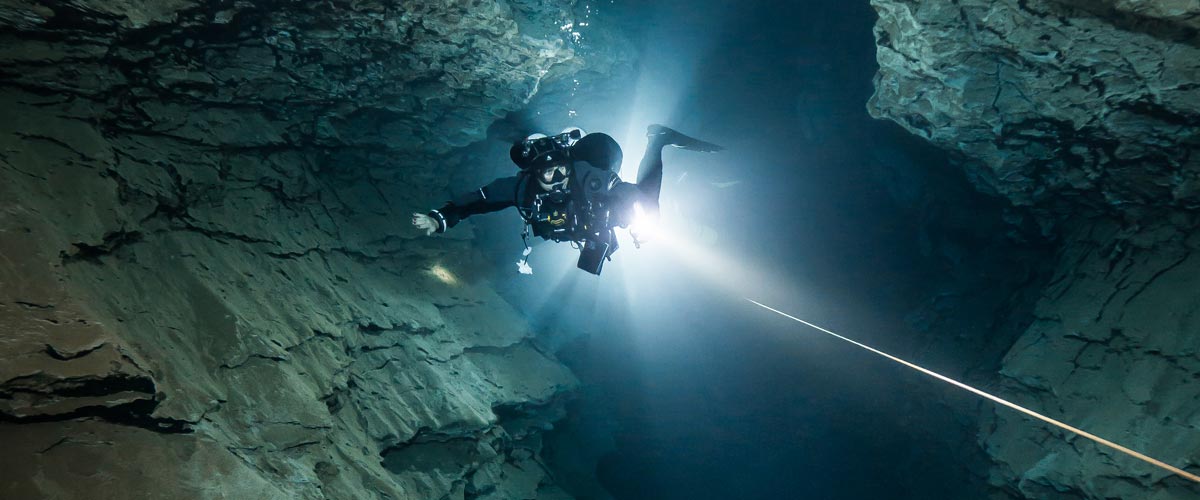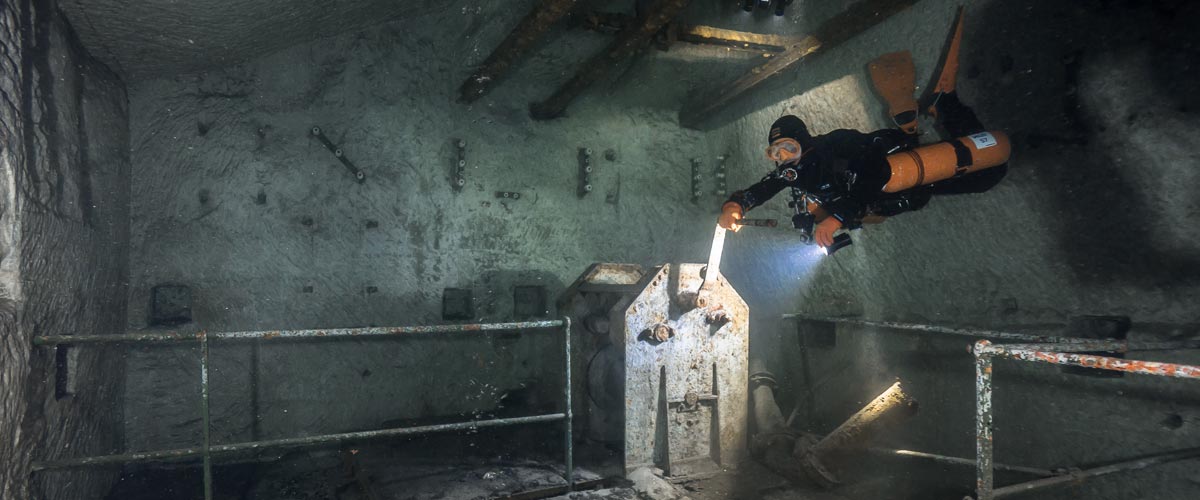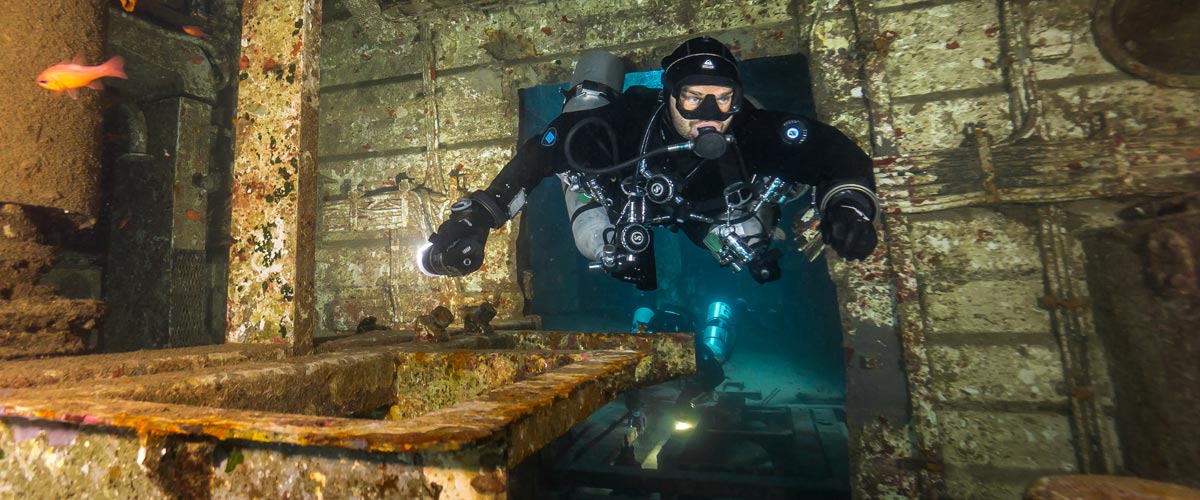Dive Training Blogs
Getting to Grips with Narcosis
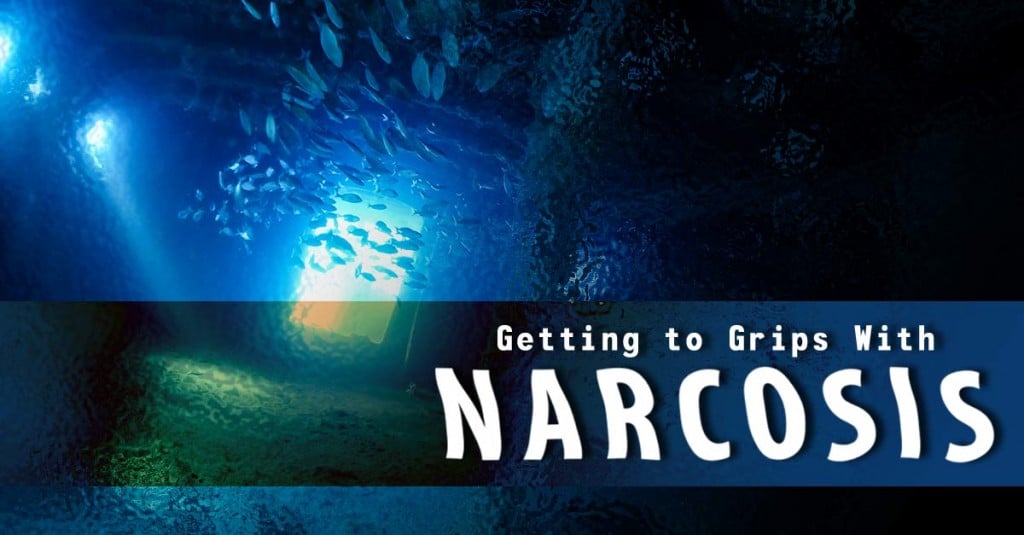
By: Richard Devanney
To a new diver, thoughts of narcosis can be very mixed. Some may find it to be a scary prospect, whilst let’s be honest others will relish the thought of getting a free thrill during a dive, which may tempt them to go deeper than their certification and/or level of competence should otherwise allow. This contrasts with a cautious, risk-averse diver. They know narcosis as something to become familiar with in a controlled environment, before taking active steps wherever possible to minimize its effects on all future dives. Now some of you may be thinking “that’s rubbish, who wants to be risk-averse!”. My response to this is that you dear reader are exactly the person that this article is aimed at.
All divers have been taught the basics of what narcosis is
All divers have been taught the basics of what narcosis is, along with what they should do to reduce its effects during a dive. At open water level narcosis isn’t really of great concern, as it’s not usually noticeable by diver nor observant buddy up to the 18m (60ft) maximum depth range. For advanced divers going to 30m (100ft), it’s your new imaginary friend, sitting on your shoulders with its feet in the stirrups, poised and ready to take over the reins. But many will hardly notice its effects. Those that do should be able to cope fairly easily- there are always exceptions to this of course. But what about going deeper than 30m- how does it affect you then? Can you maintain control? At what point will it start to control you? These are kind of important considerations, so let’s delve a little deeper to find out more.
What’s in a name I hear you ask- It’s ok, I can’t really hear you. But seeing as you probably would have asked anyway, the nomenclature originates from the Greek word narke, and loosely translates to “numb”. But it has collected a few other familiar names over the years; “the martini effect” (ridiculous), “rapture of the deep” (I was hoping that when the rapture does come I can just go for a dive and let it pass me by) I’m sure there are more names but they will be equally silly. Most people call it Nitrogen (N2) narcosis because there’s more of it in your cylinder of air than oxygen. Yet there are some people- mainly technical divers, that call it inert gas narcosis, because you know, nitrogen is inert and they crave accuracy and order. Some even more anal tech divers go further and call it gas narcosis, because they want to outdo other tech divers in the accuracy and order stakes, and also because carbon dioxide and oxygen are also narcotic (though it’s unclear as to how narcotic one is relative to the other). But for the sake of concision, I’ll call it narcosis for the rest of the article because, a- I’m a lazy typist, and b- any excuse to wind up the online dive police.
Causes
As you go deeper during a dive, narcosis will increasingly affect you in numerous ways. If you continue descending beyond both your maximum depth and better judgment (whichever comes first!), it will eventually induce an anesthetic effect on you, and there hasn’t been an alarm clock invented that will wake you up from that slumber. Thankfully, deep air diving is not in vogue anymore so there aren’t as many stories of divers descending to oblivion as there used to be.
The exact mechanism of how narcosis works is not universally agreed upon, but the theory that most diving physicians agree on is the so-called Meyer-Overton hypothesis. This states that the narcotic effect of a gas relates to its solubility in the lipid (fat) phase of body tissues. The higher the solubility of body tissues, the more readily nitrogen (and other narcotic gases) will dissolve into them (as per Henry’s law). In this case, those body tissues are the nerve membranes of the brain. It’s believed that once enough nitrogen is dissolved into the lipid membranes, it will mechanically interfere with the transmission of signals between nerve cells.
The narcotic effect of gases on humans has been quantified in terms of their so-called Relative Narcotic Potency (RNP). Of the gases used in diving, helium has the least narcotic effect when breathed. At the other end of the scale, argon has the greatest effect, which is precisely the reason it is not breathed (along with it having a high gas density). Here’s the full list of diving-related gases, ranging from the breathable to the breathable but only under certain circumstances, to the “I would love to breathe that but it’s too expensive”, and ending with the “Superman can freedive indefinitely anyway so why is it even on the list?”:
- Helium (least narcotic)
- Neon
- Hydrogen
- Nitrogen
- Argon
- Krypton
- Xenon- (most narcotic)
Helium is not narcotic at diving depths (though it affects the nervous system beyond the 100(ish) meter range due to the rate of compression- this is known as High-Pressure Nervous (or neurological) Syndrome- or HPNS. It affects the central nervous system and symptoms include myoclonic jerking and somnolence- basically, you uncontrollably shake and then fall asleep- almost the opposite of when your dog runs in its sleep).
Not being narcotic is one of the numerous reasons why helium is a good gas for deeper diving – if you can afford it
Hydrox- a mixture of hydrogen and oxygen has been used experimentally on very deep commercial diving projects by French company Comex, and when I say deep I mean humans standing on the sea bed at 500 meters deep (1,640ft). Theos Mavrostomos went to 701m (2,299 ft) in a chamber, just because he could.
However, because of its tendency to create large, messy, and often inconvenient explosions, hydrogen can only be used with 4-5% oxygen in the mixture, and therefore requires specialized equipment not to mention extensive training before it could be used- all at considerable cost. Neox- a mixture of neon and oxygen is a good alternative to helium as a deep breathing gas, as it is both not very narcotic and it doesn’t distort the voice unlike helium, but it’s very expensive to use (You can see a pattern forming here can’t you), and apparently if you do get DCS when using it, symptoms can be severe. Argon is only used to put in drysuits instead of air, and thankfully the regulator attached to the cylinder supplying it will not have a 2nd stage regulator attached, just in case you or your buddy are seeking out a Darwin award- it’s anoxic.
Symptoms
So what happens when we get narced? Do we take our regulators out to give to the fish? Generally, things are a little more subtle than that. If you descend to 30-40m (100-130ft) you may feel euphoric, lightheaded, or a little bit tingly. You may find that your ability to concentrate has reduced, and your ability to care has fallen commensurately with it. Other symptoms include perceptual narrowing (tunnel vision), altered perception of time, anxiety or paranoia, memory loss, and even a feeling of numbness. Many divers will insist that they feel nothing and think they are absolutely fine. If you ever find yourself diving on trimix between 30 and 60m (100-196ft), you will most likely have observed that, whilst you have a very clear head because you are breathing in less N2, anyone diving with you on air is noticeably slower when it comes to, well everything- communication, physical dexterity, and general coordination. Their situational awareness is almost non-existent. When watching them try to achieve a simple task, it’s all the more amusing to know that they won’t even remember how badly they were doing it- when they get back on the boat they will think that they were fine and that all their tasks were completed properly and efficiently- ignorance is bliss and relativity is difficult to gauge when everyone is riding on the same beam of light.
So how badly do these symptoms affect how in control you are during a dive?
Well, it depends on your susceptibility on the day and how deep you are; your sensitivity will change every dive; there are many factors that will influence how narced you feel on a given day. The lines are blurred as to how much of an influence each factor has on you. Tiredness, dehydration, alcohol or drugs (prescription and recreational), cold water (affects you much more than warm water), higher work of breathing, bad visibility, turbidity (particles in the water), seasickness, fear, vertigo, task loading, current, descent rate. That’s a big list of influences.
A build-up of carbon dioxide can also increase narcosis. Swimming against a current will make your breath harder, and breathing harder underwater is not very good for you because gas densities under elevated pressures are such that it is more difficult to move those gases in and out of the lungs. It’s bad enough when a regulator is forcing the air into your lungs; when you are on a rebreather you are doing the work so it’s even worse. The bigger the atom, the harder it is for you to move it. So it’s harder to expel CO2 from the lungs and consequently the body, which allows it to build up. CO2 is more narcotic than N2, but its effect on narcosis is not simply an effect of higher partial pressures of CO2. In the blood CO2 is a dissolved gas in a non-compressible fluid, so partial pressure is not the only factor at play. If it was then we would not be able to go diving because levels would quickly prove fatal as we descend. In addition to narcosis, CO2 acidifies the blood and has anesthetic properties, so hypercapnia (or excess carbon dioxide) is not very good for you. CO2 is also a vasodilator so it has an influence on CNS oxygen toxicity risk. Basically, CO2 is bad.
Staying in control
The thing about narcosis is, that it’s very easy to get complacent about it. There is such a thing called normalization of deviance. It’s not a diving thing, it’s a human thing, so divers do it because they are usually human. It’s basically becoming accustomed to bad/unsafe behavior because it’s done so much without any negative consequences that it’s not considered bad/unsafe anymore; it’s considered the norm. A great example is a professional videographer filming open water groups in between solo diving to get the shots they need, but without the qualification, training, and redundant gas source. Another example is not doing a full or thorough buddy check before diving. There are countless other examples. People continue bad behaviors because 99 times out of 100 nothing will go wrong. But something only needs to go wrong once.
With narcosis, you may feel anxious during a 30m dive, or just so spaced out that you hardly check your air and don’t keep track of your buddy. These are not good things, but you made it back to the boat so it must have been ok- you’ll just continue to deal with it. But what if something does go wrong, what if your buddy gets very low on gas and you need to share? Will you be able to act on this quickly and safely when you already have a head full of anxiety or are feeling mentally slow, or have poor motor skills- or all three? We know that most accidents occur because of numerous factors rather than one single thing. If something goes wrong, isn’t dealt with and it leads to another thing going wrong, then the odds may be stacked high against a safe outcome because there’s just too much going on in a critically short window of time. Call it the domino effect or the incident pit or whatever you want.
Now just so you know I’m not trying to be dramatic, I know that the chances are that for most people in the 30m (100ft) range and even the 40m (130ft) range, a low on air diver or BC malfunction etc will usually be dealt with to provide a safe outcome. They may be messy but hey, you’re narced. Remember by the time you’re back on board the boat you’ll think you did a great job of it anyway! This is just an article to hopefully make you ponder some things in your diving that you maybe don’t think about too much.
So how about at between 40m and 55m (130-180ft)?
I shouldn’t really have to mention that going beyond 55m on air is not a good idea, with narcosis being one reason why. You will be on another planet mentally and as you continue to descend you will find yourself completely incapacitated before the inevitable unconsciousness arrives. Some people don’t think you should really be going beyond 30m on air (yes I’m one of them, but I also know that trimix is prohibitively expensive). Yet at these kinds of depths, you really do have to exercise very conservative judgment about your ability to deal with things going right, along with your ability to cope and solve problems if things go wrong, not simply whether you will manage to do the dive with no issues. If you have any inkling whatsoever that you may not be able to handle yourself or your team mate being out of gas or tangled up, it’s probably time to get your trimix qualification. The helium in trimix offsets some of the nitrogen so you feel more clear-headed. The problem with doing these dives without trimix is that you are impaired remember, so you don’t have good judgment in the first place! You won’t really know until it all goes wrong. Sure, you can practice going to 50m and do some drills to see if you get better/faster/more efficient at them, but remember the trimix divers watching the air divers? Don’t kid yourself. A big part of risk management involves being honest with yourself.
Minimising narcosis
So what can you do about it? As with most things technical diving, risk management begins on land before you even start day dreaming about how great you look in a wetsuit. You’ll need to think about:
- What’s your dive plan- how deep do you want to dive?
- What do you want to achieve on the dive, what are your objectives, are they complex/simple?
- What’s the weather like? Will it get choppy? Will there be a current? Could the weather change during the dive?
- How cold is the water? Will there be a thermocline? Wetsuit or drysuit- heated vest?
- Visibility good or bad, turbidity?
- What’s the competence of your dive team? Is there a big difference in competence?
- How many people are you diving with? Who is doing what?
- Could you use gases other than air (helitrox or trimix)?
- Will you free descend or use a shot, can you do a slow, staged descent?
- Is it a decompression dive?
- How good is your regulator, is it appropriate for the depth you want to dive in terms of ease of breathing, i.e. balanced?
If you think about it, none of the above are new things to think about
You should be considering them in some form or another on every dive. But you could also ponder your water entry, will you have to swim hard against a surface current to get to a descent line? Can you have a rest before descending? You shouldn’t be out of breath during a dive so being out of breath immediately before is a little bit silly. Can you descend in a slow and controlled way? Staging your descent and descending slowly can help reduce task loading with ear equalization, equipment comfort and settling into the dive. It will also provide a gradual increase in nitrogen exposure to the brain in terms of PPN2. This is extremely anecdotal but I personally don’t want to drop like a stone and find myself suddenly hit by a wall of fuzziness- but that’s just me.
Whether it’s a decompression dive or not is markedly different to a no-stop dive. The usual advice on narcosis is that if you don’t like the feeling then ascend and it will disappear. Whilst that’s true, for a deco dive the missing component of that is “in how long”. I have done many a deco dive where I know I am narced, and as I ascend and switch to 50% Oxygen…. Yep, still narced.. time to move up to 12m now, yep, still narced. There is a noticeable delay, even after breathing a gas with less N2 before the effects start to disappear. If you have to navigate back to a specific point during your ascent and the vis is not great, maybe take that into account.
Another consideration about decompression dives is the complexity of your plan
Technical divers plan dives, they also plan contingencies. Some plan contingencies of contingencies. Then they are all written on slates or wet notes to view during the dive. The main plan, over depth/over time, over both, one lost gas, another lost gas, multiple lost gases, minimum gas, ascent pressure, turn pressure. Many variations of these.
Dive planning is important, as is contingency planning
So what am I getting at? Well having 3 or 4 plans written down is all well and good, but what about when you’re narced, and you find that you have to actually use one of the backup plans? It’s stressful and can be complicated depending on how narced you might feel. Yes, practice practice practice I hear you say, but it’s the instructors saying that and it’s easy for them to say- it’s their job to dive every day. They will find these things easier, otherwise, why are you going to them? It’s a bit harder for people that do it as a hobby to get in anywhere near as much practice as they would like.
So here’s the real question, aimed at hobby divers. Who out there will tell me that they will immediately refer to their back up plan and utilize it correctly if a real emergency occurs at depth? It’s more likely a case of deal with the immediate problem, start heading up, and then at the first available opportunity take stock and think about how much you deviated from everything because there were more pressing things going on than referring to back up plans. By then all your plans could be completely irrelevant. So let’s get down to brass tacks and be realistic- how complicated is your plan? Can you simplify it anymore to make it easier to read/use when needed? This might be the way it’s written down, the way you compare total runtime to your bottom timer, it may even be as simple as ensuring that you have a dive computer with a stopwatch function (yes please in dive mode as well as gauge mode shearwater, hint hint). Why do you think you might go over depth or over time? Can you actually do the dive with a simple plan and back up plan in your head? Again, just things to ponder.
One of the biggest things to factor in is who you are diving with…
You may be lucky enough to have friends that you regularly dive with, who are sensible and you dive well together. That’s great. The alternative is when you dive with people you don’t know. Of course there will always be people with different levels of experience and competence and after all, diving can be a great way to meet new people and learn new things. I’m not talking about deep decompression dives either, just regular dives to 30-40m. I’m talking about a specific type of person. Basically, don’t dive with the person at the beginning of this article who’s aim is to get as narced as possible. They are rule-breakers, and in my opinion, potential life-takers. There are plenty of real-world stories of this kind of person ignoring a dive briefing and taking someone equally unskilled, inexperienced and unqualified inside a wreck or cave, to find themselves trapped, or find their way out but the buddy doesn’t. Swap wreck for depth and the outcome may be the same. Diving is not a competitive sport (Though I sometimes wonder that when browsing certain Facebook groups), and the laws of physics apply to everyone.
Like most things, diving procedures, equipment considerations and the like are not rocket science once learned properly, but there are numerous things to consider. One that is often neglected is risk management, and certainly risk management as it relates to narcosis. We often just get on with it and assume everything will be ok. But as I’ve said a few times you only need things to go wrong once. So be prepared, know your limits and set them accordingly not just based on yourself, but also based on who you are diving with, when, and where.
Maybe it’s time to see what the fuss is about with trimix.
To find out more about International Training, visit www.tdisdi.com.

Blogs
Intro to Tech: What is it about?
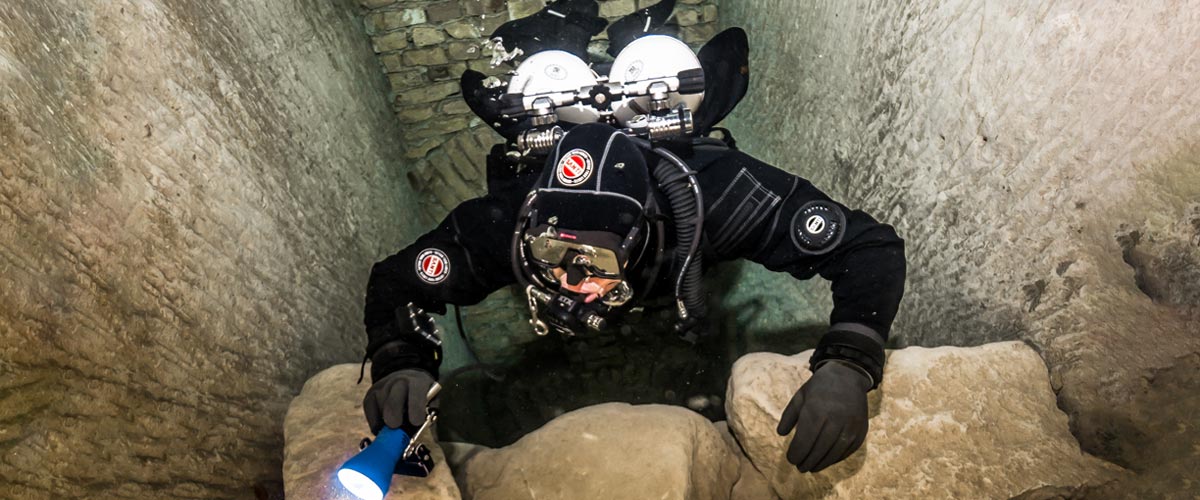
Article by José Pablo Mir
Pictures by Cezary Abramowski
The world of technical diving is exciting. It opens the door to new sites, depths, and bottom times. More importantly, it opens our minds to a new way of planning, facing, and experiencing dives, even those not purely technical.
Becoming a technical diver is a process, and like in other aspects of life, we should find the proper entry point that suits us best based on our knowledge and experience. The Introduction to Technical Diving course from TDI -the world’s largest and most recognized technical diving teaching organization- is the best option for divers who have yet to gain experience in the fundamental aspects of this new practice. The course’s content and its embrace of new techniques and technologies make it possible to acquire a solid foundation to learn and gain experience in this practice properly.
Becoming a technical diver is not something that happens overnight, whether deciding to become one or receiving a certification card stating we are now technical divers. It is a slow process extending farther away than any introductory course. It requires effort and dedication. But it will bring us satisfaction from day one -or two.
It is a matter of mentality
First, we must understand and accept that technical diving, involving greater depths, longer bottom times, exotic gases, virtual or real ceilings, and more, comes with higher levels of risk than the sport diving we have been practicing until now.
Although this discussion usually starts with a warning about risks, as I’ve done in the previous sentence, our practice is not a game of chance.
Technical diving is a rational activity that requires maturity and good judgment, and we will put everything into ensuring that each dive is a successful one -meaning we return from it safe and sound. With this understanding, we will strive to establish a mental attitude more aligned with our practice and its realities.
This new “technical diver” mindset we will develop will lead us to be more cautious in our executions, more analytical in our plans, more rational in our strategies, and more detailed in our procedures.
Experience will keep teaching us to know ourselves better, to keep our anxiety and other emotions under control, and to manage our impulses. Over time, our senses will sharpen, and we will be more attentive to the particulars of the situation we find ourselves in.
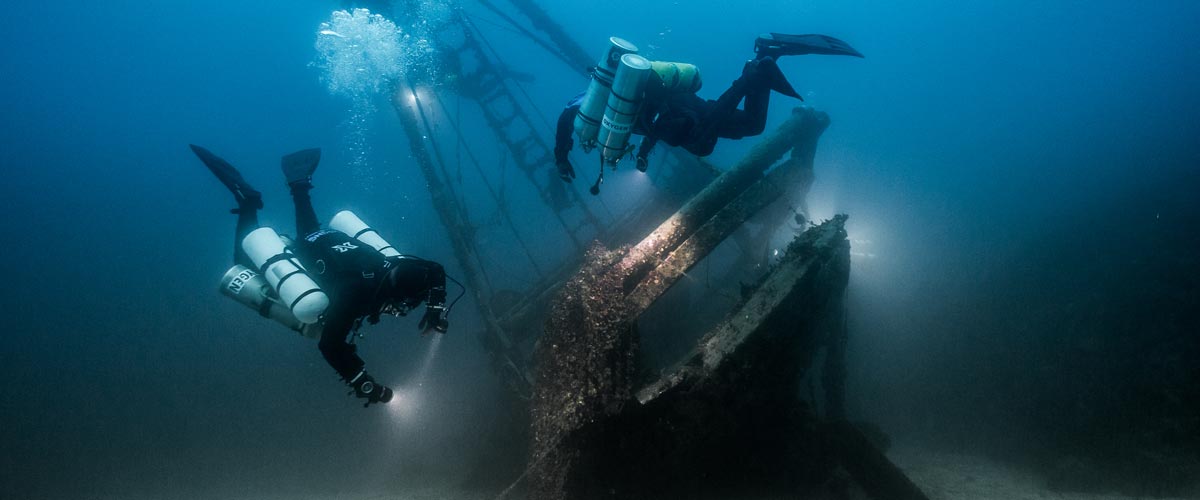
Strategies and procedures
Our strategies, those broad guiding lines tracing the path to follow, from how to approach planning to where, with what, and how we are willing to get there, will be more specific and more practical. Not because they magically become so, but because we will consciously and deliberately frame them that way.
We will establish clear, concise, and realistic procedures. Not only for the undesirable situations that may present themselves but also for those that are part of our dive objectives.
Even though, as technical divers, we often use equipment different from what we were previously accustomed to, it is essential to note that the gear does not make the diver. In a way, we could consider such equipment as the necessary tools to implement what our goal seeks to achieve, according to our strategies and procedures.
Technique plays an important role
We must put our greatest effort into learning and perfecting the different techniques we will be acquiring. Buoyancy, trim, propulsion, cylinder handling, deploying DSMBs and lift bags, valve drills, and more are essential skills we must begin to master to progress in our art. What we cannot do, when we need to do it, can harm us.
Our techniques must be effective and achieve the purpose for which they were devised. But they must also be efficient and require the least resources possible, including the time they take and the effort they demand. Effectiveness and efficiency will prevail over beauty and other considerations that may come to mind, although none of them should be mutually exclusive. A technique executed efficiently and effectively tends to have an inherent beauty.
Refining techniques is a lifelong mission. Some of them will be easy to master from the go; others, on the other hand, will be our life mission and will require many repetitions just to resemble the idea we have in mind of how they should be executed.
We must consider the environment
Our learning, the needs and musts of the practice we engage in, the experience we gradually gain, our strategies and procedures, and even our equipment and tools change with the environment.
Diving in the ocean, everything about us must be suitable for ocean dives. Conditions there rarely emulate those found in a pool, lake, or river. Variable winds and currents, greater depths, visibility conditions, other divers with uncertain skills around us, marine life, maritime traffic, distance from the coast, and many other factors add complexity and uncertainty.
It is never necessary to master the pool on the first day, but planning and aspiring to gradually cope with the ocean’s conditions is essential.
The cost of good training
We are aware that our resources are often scarce in relation to the possibilities of use we could give them if they were not. To a greater or lesser extent, we are part of the economic reality in which we are embedded.
Fortunately, the cost of good technical diver training is not an entry barrier. Comparing training and equipment costs, we see that the former are generally lower. Yes, lower cost for personalized service, essential to our future
performance and safety, than for a series of mass-produced products that are mere, albeit necessary, tools for an end.
The value of good training
The value of the training we received encompasses a range of characteristics, from emotional and methodological to technical and technological. TDI and its Introduction to Technical Diving course offer a deep and modern approach, with a teaching strategy that aims to create thinking divers, not merely obedient ones.
As technical divers, our knowledge is our primary tool. In this type of activity, what we don’t know can harm us.
Is this course optional?
Unfortunately, the fact that this Introduction to Technical Diving course is not a prerequisite for any subsequent training is an invitation to consider it optional. And we all know what usually happens to “optional” under budget constraints.
However, this course should be seen as optional only by those divers who are somehow familiar with the use of technical equipment, who have a mindset more in line with the requirements of this type of diving, who plan and execute the dives the proper “technical” way, who know their gas consumption rate, who are not intimidated by non-decompression tables, who feel comfortable using their dive computers, and know the techniques and have at least an acceptable level of buoyancy, positioning, and propulsion. Those can go straight to a more advanced training course, such as TDI’s Advanced Nitrox.
We must ask ourselves whether or not we are in that group.
Remember our goal: to have fun
Recreational diving is our passion. Jumping into the water carrying heavy equipment and having properly dotted our I’s and crossed our T’s have only one ultimate goal: fun. This is the activity we have chosen as a hobby. We must enjoy it; it must give us pleasure and make us vibrate.
Having a good time is not optional!
Blogs
Four opportunities to go pro in 2024 with Dive Friends Bonaire
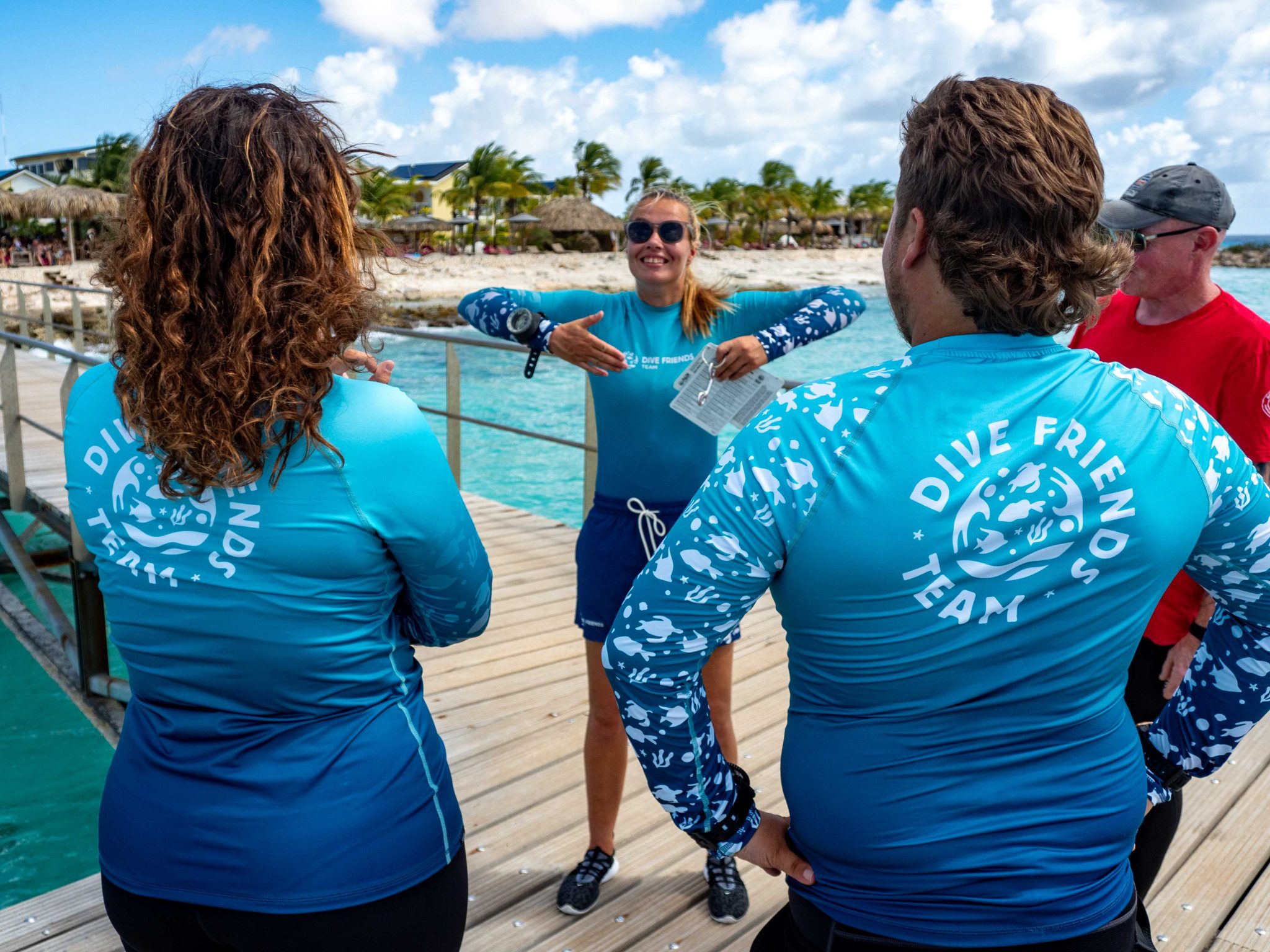
Dive Friends teaches the Instructor Development Course (IDC) several times a year to students who are eager to share their passion for diving with the world.
Dive Friends is known for the personal approach throughout the course. Their in-house course director will lead the students through every essential step, mentoring them to achieve their fullest potential as a dive instructor.
Applications for the following IDC start dates are now open:
- 12 April
- 5 July,
- 20 September
- 29 November
Partnership with Casita Palma
If the student opts for the IDC-Deluxe or IDC-Supreme package, their accommodation will be arranged for them at Casita Palma. This small and quiet resort is within walking distance from Dive Friends Bonaire’s main dive shop location and has everything you need to relax after an intense day of IDC training. Breakfast is included, so the student will always be fuelled and ready for their day.
Contact Dive Friends Bonaire’s Course Director Eddy for more information: coursedirector@divefriendsbonaire.com.
-

 News3 months ago
News3 months agoHone your underwater photography skills with Alphamarine Photography at Red Sea Diving Safari in March
-

 News3 months ago
News3 months agoCapturing Critters in Lembeh Underwater Photography Workshop 2024: Event Roundup
-

 Marine Life & Conservation Blogs2 months ago
Marine Life & Conservation Blogs2 months agoCreature Feature: Swell Sharks
-

 Blogs2 months ago
Blogs2 months agoMurex Resorts: Passport to Paradise!
-

 Blogs2 months ago
Blogs2 months agoDiver Discovering Whale Skeletons Beneath Ice Judged World’s Best Underwater Photograph
-

 Gear Reviews3 months ago
Gear Reviews3 months agoGear Review: Oceanic+ Dive Housing for iPhone
-

 Marine Life & Conservation2 months ago
Marine Life & Conservation2 months agoSave the Manatee Club launches brand new webcams at Silver Springs State Park, Florida
-

 News3 months ago
News3 months agoWorld’s Best Underwater Photographers Unveil Breathtaking Images at World Shootout 2023















